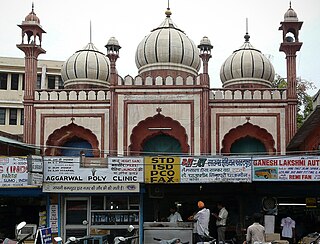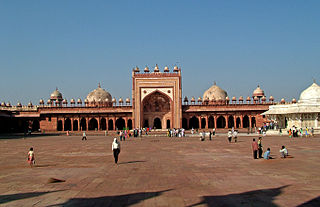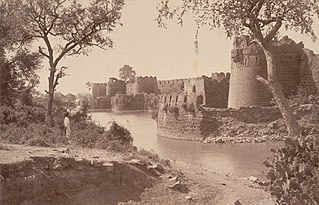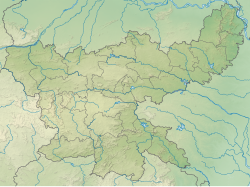
The Masjid-i-Jehan-Numa, commonly known as the Jama Masjid of Delhi, is one of the largest Sunni mosques in India.

Mughal architecture is the type of Indo-Islamic architecture developed by the Mughals in the 16th, 17th and 18th centuries throughout the ever-changing extent of their empire in the Indian subcontinent. It developed from the architectural styles of earlier Muslim dynasties in India and from Iranian and Central Asian architectural traditions, particularly Timurid architecture. It also further incorporated and syncretized influences from wider Indian architecture, especially during the reign of Akbar. Mughal buildings have a uniform pattern of structure and character, including large bulbous domes, slender minarets at the corners, massive halls, large vaulted gateways, and delicate ornamentation; examples of the style can be found in modern-day Afghanistan, Bangladesh, India and Pakistan.

The Moti Masjid is a 17th-century mosque inside the Red Fort complex in Delhi, India. It was built by Mughal emperor Aurangzeb, damaged during the Siege of Delhi, and subsequently restored by the British. Named for its white marble, the mosque features ornate floral carvings. It is an important example of Mughal architecture during Aurangzeb's reign.

Indo-Islamic architecture is the architecture of the Indian subcontinent produced by and for Islamic patrons and purposes. Despite an initial Arab presence in Sindh, the development of Indo-Islamic architecture began in earnest with the establishment of Delhi as the capital of the Ghurid dynasty in 1193. Succeeding the Ghurids was the Delhi Sultanate, a series of Central Asian dynasties that consolidated much of North, East, and Central India, and later by the Mughal Empire during the early 16th century. Both of these dynasties introduced Islamic architecture and art styles from West Asia into the Indian subcontinent.

The Jamia Masjid is a Friday mosque, located at Nowhatta in the Old City of Srinagar, in the union territory of Jammu and Kashmir, India. The mosque was commissioned by Sultan Sikandar in 1394 CE and completed in 1402 CE, at the behest of Mir Mohammad Hamadani, son of Mir Sayyid Ali Hamadani, and is regarded as one of the most important mosques in Kashmir. The mosque is located in a central zone in the religio-political life in Srinagar. Thronged by Muslims every Friday, it is a prime tourist attraction of the city.
Ashti(Shahid) is a town and the tehsil headquarters in Arvi subdivision of Wardha district in the Indian state of Maharashtra. Ashti is a historical place famous for the participation in Indian independence movement and Tomb of Nawab Muhammad khan Niazi. People actively took part in Quit India Movement in 1942. Ashti is also known as shahidon ki Ashti.

Lal Masjid of Delhi, also known as the Fakr-ul Masjid or Sikandar Sahib's Masjid, is a mosque located in Bara Bazaar, Kashmiri Gate in Old Delhi, India.

The Jama Masjid of Bijapur is a congregational mosque in the Indian state of Karnataka. Initiated by Ali Adil Shah I of the Bijapur Sultanate in the 16th century, the mosque was never completed. It is the largest mosque in Bijapur, and has a capacity of 4000 worshippers.

The Jama Mosque is a 17th-century congregational mosque located in the historic core of Agra, Uttar Pradesh. It was built by Jahanara Begum, the eldest daughter of Mughal Emperor Shah Jahan, during the latter's reign. It is the principal mosque in the city of Agra, and lies close to Agra Fort.

The Jama Masjid is a 16th-century congregational mosque in the UNESCO World Heritage Site of Fatehpur Sikri, located in Uttar Pradesh, India. It was built by Mughal emperor Akbar, and was the largest mosque in the empire at the time of construction. The Jama Masjid's design drew from earlier mosques built by various pre-Mughal sultanates, and served as an important precedent in subsequent Mughal architecture.

The Fatehpuri Mosque, also Fatehpuri Masjid, is a 17th-century Sunni mosque, located at the western end of the oldest street of Chandni Chowk, in the Old Delhi neighbourhood of Delhi, India. The mosque is opposite the Red Fort and, after Jama Masjid, is the second largest mosque in Delhi.
Humayun Mosque is situated in the village of Kachhpura in Agra, Uttar Pradesh, India on the left bank of River Yamuna.

The Gulbarga Fort is located in Kalaburagi in the Kalaburagi district of North Karnataka. The fort was originally constructed by the Hindu monarch Raja Gulchand, and it was subsequently significantly enlarged in 1347 by Ala-ud-Din Bahman Shah of the Bahmani Kingdom after he cut off his ties with the Delhi Sultanate. Islamic monuments such as mosques, palaces, tombs, and other structures were also built later within the refurbished fort. The Jama Masjid, built later within the fort in 1367, is a unique structure built in the Persian architectural style, fully enclosed with elegant domes and arched columns. It was built to commemorate the establishment of the dynastic rule of the Bahmani Kingdom at Gulbarga Fort between 1347 and 1424. It remained the capital of the Bahmani Kingdom until 1424 where after the capital was shifted to Bidar, which had better climatic conditions.

The Sunehri Masjid is an 18th-century mosque in the Chandni Chowk neighbourhood of Old Delhi, India. It was built by Mughal noble Roshan-ud-Daula, during the reign of Emperor Muhammad Shah. It is located near the Gurudwara Sis Ganj Sahib in Chandni Chowk, once an imperial boulevard leading to the Red Fort.

Persian Inscriptions on Indian Monuments is a book written in Persian by Dr Ali Asghar Hekmat E Shirazi and published in 1956 and 1958 and 2013. New edition contains the Persian texts of more than 200 epigraphical inscriptions found on historical monuments in India, many of which are currently listed as national heritage sites or registered as UNESCO world heritage, published in Persian; an English edition is also being printed.

The Jama Mosque is a Friday mosque, located in Kotwali Bazar, Dharamshala, in the state of Himachal Pradesh, India.

The Jama Mosque, or Jama Masjid, is a Sunni Islam mosque, located in Bhilai, Chhattisgarh, India. The mosque was completed in the 1960s and can accommodate 3,000 worshippers at a time and is one of the largest mosques in the state, and also in Asia. It is the first mosque in the world to be built in the shape of the word "Ya Allah" in Arabic script. It took three years for the construction of the mosque which was completed in 1967.

The Moti Masjid is an 18th-century Mughal mosque located in Mehrauli, Delhi. Named for its white marble, the mosque was constructed during the reign of Bahadur Shah I, in the vicinity of the dargah of Qutbuddin Bakhtiar Kaki.

The Zeenat-ul-Masajid, also written as Zeenat-ul-Masjid and popularly known as the Ghata Masjid, is an 18th-century Mughal mosque located in Delhi, India. The mosque was commissioned by Zeenat-un-Nissa, second daughter of the Mughal emperor Aurangzeb.

The Jama Masjid is an historic Friday mosque, located in Shopian, in the union territory of Jammu and Kashmir, India. The mosque was built during the Mughal period and is very beautiful from both inside and outside. It's considered one of the best mosques in the Shopian district.




















